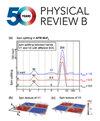Vortex frequency locking and Shapiro steps in superconductor open nanotubes
IF 3.7
2区 物理与天体物理
Q1 Physics and Astronomy
引用次数: 0
Abstract
The movement of magnetic flux quanta (Abrikosov vortices) in superconductors leads to dissipation and is influenced by various ordering effects arising from vortex-vortex, vortex-defect, and vortex-edge interactions. Under combined dc and ac stimuli, when the distance traveled by fluxons during an ac cycle corresponds to an integer multiple of the vortex lattice period, the superconductor's current-voltage (I−V) curve displays synchronization (Shapiro) steps. However, in planar constrictions, frequency-locking effects rely on a perfectly ordered vortex lattice and are typically observed when periodic vortex pinning arrays dominate over intrinsic uncorrelated disorder. Here, we propose 3D superconducting open nanotubes as systems free of periodic disorder, where the超导体开孔纳米管中的涡旋频率锁定和夏皮罗步骤
超导体中磁通量子(Abrikosov涡旋)的运动导致耗散,并受到涡旋-涡旋、涡旋-缺陷和涡旋-边缘相互作用引起的各种有序效应的影响。在直流和交流的联合刺激下,当交流周期中通量子所走的距离对应于漩涡晶格周期的整数倍时,超导体的电流-电压(I−V)曲线显示同步(夏皮罗)步骤。然而,在平面收缩中,频率锁定效应依赖于完美有序的涡旋晶格,并且通常在周期性涡旋钉住阵列优于本征不相关无序时观察到。在这里,我们提出了3D超导开放纳米管作为无周期性无序的系统,其中I - V曲线有望显示明显的夏皮罗阶跃。利用随时间变化的金兹堡-朗道方程,我们将预测效应归因于涡旋运动维数的降低。也就是说,将平面薄膜卷成管状,会导致最初在薄膜中移动的二维涡流阵列演变成准一维涡流链,这些涡流链被限制在磁场法向分量接近最大值的区域。所讨论的效应与超导器件有关,其中涡旋成核频率和电压稳定的外部交流刺激可以提高他们的工作。2025年由美国物理学会出版
本文章由计算机程序翻译,如有差异,请以英文原文为准。
求助全文
约1分钟内获得全文
求助全文
来源期刊

Physical Review B
物理-物理:凝聚态物理
CiteScore
6.70
自引率
32.40%
发文量
0
审稿时长
3.0 months
期刊介绍:
Physical Review B (PRB) is the world’s largest dedicated physics journal, publishing approximately 100 new, high-quality papers each week. The most highly cited journal in condensed matter physics, PRB provides outstanding depth and breadth of coverage, combined with unrivaled context and background for ongoing research by scientists worldwide.
PRB covers the full range of condensed matter, materials physics, and related subfields, including:
-Structure and phase transitions
-Ferroelectrics and multiferroics
-Disordered systems and alloys
-Magnetism
-Superconductivity
-Electronic structure, photonics, and metamaterials
-Semiconductors and mesoscopic systems
-Surfaces, nanoscience, and two-dimensional materials
-Topological states of matter
 求助内容:
求助内容: 应助结果提醒方式:
应助结果提醒方式:


